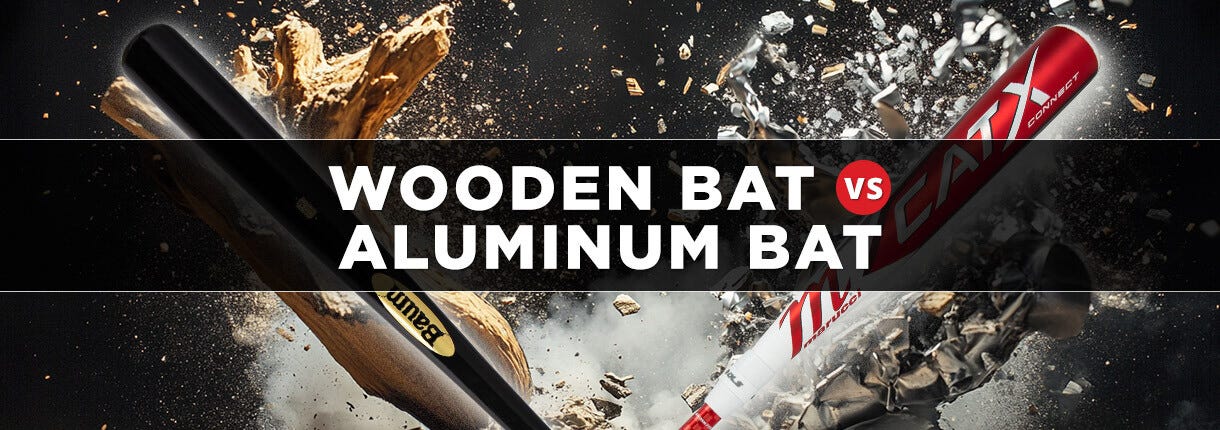Wood vs. Aluminum Bat: Performance, & Durability Comparison

In this article, we will cover:
The debate between wooden and aluminum bats has long been a point of contention among players, coaches, and enthusiasts in baseball. Each type of bat has its passionate advocates, with wooden bats traditionally favored for their classic feel and authenticity, while aluminum bats are praised for their durability and performance-enhancing qualities. As players look to optimize their game, understanding the critical factors that differentiate these two types of bats is essential. This comparison will explore aspects such as performance, cost, weight, and usage regulations, providing a comprehensive overview to help players make informed decisions about which bat best suits their needs. For more guidance, check out our article on How to Choose the Right Baseball Bat.
Overview of Wood vs Aluminum Bats
The table below highlights the types of materials used in baseball bats, essential for players and coaches to refine their hitting strategies and choose the right equipment. Wood bats, made from materials like maple and ash, offer a traditional feel and are popular in professional play but are less durable. Alloy and composite bats are lighter, more durable, and preferred in amateur leagues for faster swings and consistent performance.:
| Characteristic | Wooden Bats | Aluminum Bats |
|---|---|---|
| Types of Materials Used | Offers a traditional feel with a solid sound on contact, often preferred by players for its authenticity." | Generally lighter and more balanced, allowing for quicker swings and increased bat speed." |
| Typical Use | Primarily used in professional leagues (e.g., MLB) and by serious players who appreciate the craft. | Commonly used in amateur and youth leagues due to their durability and performance benefits. |
| Durability | More prone to breaking and wear, requiring regular replacement, especially with heavy use. | Highly durable, designed to withstand repeated impacts without significant wear or damage. |
| Weights | Generally heavier, which can contribute to power but may affect swing speed for some players. | Typically lighter, allowing for increased swing speed and control, making them ideal for younger players. |
Metal Bat vs Wooden Bat: Performance Comparison
The overview below examines the factors influencing the choice between wooden and aluminum bats, crucial for players and coaches to optimize their performance.
| Factor | Wooden Bats | Aluminum Bats |
|---|---|---|
| Bat Speed and Power | Generally heavier, which can contribute to greater power but may reduce bat speed for some players. | Lighter design allows for faster swings, enhancing bat speed and control, which can improve overall performance. |
| Sweet Spot Size | Typically has a smaller sweet spot, requiring more precision in hitting to achieve optimal performance. | Larger sweet spot, making it easier for players to make solid contact and achieve better results on hits. |
| Impact on Gameplay | Offers a more traditional experience and is favored in professional play for its authenticity and feel. | Enhances performance in amateur and youth leagues, promoting confidence and improved hitting results. |
| Lifespan | Generally shorter lifespan; wooden bats can break easily, requiring more frequent replacements. | Longer lifespan; designed for durability and can withstand repeated use without significant damage. |
| Cost | Typically more expensive, especially high-quality models, due to the craftsmanship involved. | Generally more affordable, especially for entry-level models, making them accessible for younger players. |
| Suitability for Different Levels of Play | Preferred at the professional level, often required in college leagues, but may not be ideal for beginners. | Widely used in amateur, youth, and recreational leagues, suitable for players of all skill levels. |
For a more in-depth exploration of bat types and preferences, check out our article A Complete Guide to the Different Types of Baseball Bats & Bat Preference: Wood, Alloy, or Composite.
Safety Considerations and League Regulations
Safety Issues:
- Aluminum bats can cause higher ball exit speeds, increasing the risk of injury to players, especially pitchers and infielders.
Wooden bats are less likely to create extreme ball speeds but can shatter, creating potential hazards from flying debris.
MLB Regulations:
- Only wooden bats are permitted in MLB games, maintaining traditional gameplay and reducing the risk associated with high ball speeds.
NCAA Regulations:
- Aluminum and composite bats are allowed in NCAA baseball, but they must meet specific performance standards (BBCOR certification) to control ball exit speeds and improve player safety.
High School Regulations:
- Similar to the NCAA, high school baseball leagues allow aluminum bats but require BBCOR-certified bats to ensure safety and fair play, while some youth leagues mandate USA Bat standards for younger players.
Youth Baseball Regulations:
- At the youth level, metal bats are allowed, but must meet USSSA or USA certifications. The league or tournament will dictate what certification they will follow.
For more information on bat certification, consider checking our our article on BBCOR vs USSSA vs USA Bats: What’s the Difference?
Wood vs. Aluminum Bat - Frequently Asked Questions
Can aluminum bats be used in professional baseball leagues?
No, professional leagues like MLB only allow wooden bats to maintain traditional gameplay and reduce safety risks from high ball exit speeds.
How often should wooden bats be replaced?
Wooden bats should be replaced as soon as they show signs of cracking or breakage, which may occur frequently with heavy use.
What are the environmental impacts of producing aluminum bats?
Aluminum bat production has a higher environmental impact due to energy-intensive mining and processing, while they are also less biodegradable than wooden bats.
Are composite bats considered wooden or aluminum?
Composite bats are neither wooden nor aluminum; they’re made from layered materials like carbon fiber or fiberglass, designed for durability and performance.
What is the best wood bat material for durability?
Maple is considered the most durable wood for bats, providing both strength and density.
Are wood bats heavier than aluminum?
Yes, wood bats are generally heavier than aluminum bats, affecting swing speed and control.
Is a wood bat or aluminum better?
Aluminum bats are generally better for performance, especially in youth and amateur leagues, while wooden bats are preferred for their traditional feel and are required in professional leagues.






Login and Registration Form
or
Create an account